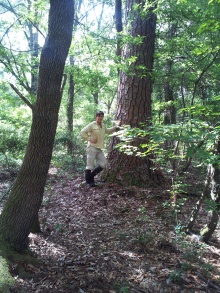
| August 5, 2013 | |
Environment: Alabama, Long Beach & Los Angeles
![]() Print this Article | Send to Colleague
Print this Article | Send to Colleague
In Alabama, two trees owned by the state port authority have been designed as 2013 Champion Trees by the Alabama Forestry Commission. In Southern California, the ports of Long Beach and Los Angeles honored five companies for their extraordinary efforts to fight harmful emissions at the 6th Annual Clean Air Action Plan Air Quality Awards.
Alabama: Port Authority Wetlands Area Home to Champion Trees
Two trees owned by the Alabama State Port Authority (ASPA) have been designated 2013 Champion Trees by the Alabama Forestry Commission (AFC). The program honors the largest tree of each species in Alabama. Of the 27 trees nominated this year, 12 were selected by species, size, trunk circumference, height and crown spread.
The port authority’s trees, a Pond Cypress and a Slash Pine, are located at its Muddy Creek Wetlands Management Area in Theodore, Alabama. The Pond Cypress (Taxodium ascendens) measured 92 feet in height with a 32-foot canopy and a 131-inch trunk circumference. The Slash Pine (Pinus elliottii) also measured 92 feet in height with a 53-foot canopy and a 118-inch trunk circumference. Both are expected to be marked with AFC Champion plaques later this year.
Initiated in 1996, the port authority’s Muddy Creek project restored wetlands and coastal plain habitat along a creek basin running through 200 acres of ASPA-held land. It also removed and controlled invasive plant species that were choking out native longleaf and slash pine, tupelo gum, sweet bay magnolia and coastal plan grasses.

This 92-foot tall Slash Pine in the Alabama State Port Authority’s Muddy Creek Wetlands Management Area was recently designated an Alabama Champion Tree.
Photo/Alabama State Port Authority
Photo/Alabama State Port Authority
Long Beach/Los Angeles Ports Announce Clean Air Action Plan Award Winners
The ports of Los Angeles and Long Beach honored five companies for their extraordinary efforts to fight harmful emissions at the 6th Annual Clean Air Action Plan (CAAP) Air Quality Awards held July 18 in San Pedro.
"The significant air quality improvements that our two ports have achieved would not be possible without the leadership, cooperation and initiative of the tenants and customers doing business here," said Los Angeles Port Executive Director Geraldine Knatz, Ph.D.
"Because of the innovative initiatives of our partners, overall diesel emissions are down by an amazing 75 percent, and we continue to advance toward our goal of zero emissions," said Port of Long Beach Acting Deputy Executive Director Noel Hacegaba, Ph.D.
The CAAP Air Quality Awards began shortly after the ports of Los Angeles and Long Beach approved the historic San Pedro Bay Ports Clean Air Action Plan in 2006. Port tenants and other port-related businesses are eligible to submit award entries, which are judged by a panel composed of port staff and representatives from the South Coast Air Quality Management District, California Air Resources Board and the U.S. Environmental Protection Agency.
Awards this year were made in three categories:
Air Quality Leadership at the Corporate Level
- Wallenius Wilhelmsen Logistics (WWL) – Since 2004, WWL has adhered to a 1.5 percent global fleet sulfur fuel policy, though regulations called for less restrictive limits between 3.5 and 4.5 percent. In addition, WWL’s new, ultra-modern "Salome" vessel was the first to qualify in 2012 for an incentive under the Port of Long Beach’s Green Ship Incentive Program, a voluntary clean air initiative that rewards ocean carriers whose ships are equipped with Tier II or III engines. WWL has also voluntarily allowed for third-party verification of its greenhouse gas emissions annually since 2009.
- OOCL USA Inc. – In 2012, OOCL signed a "green lease" with the Port of Long Beach, pledging to reduce harmful emissions by 50 percent by using shore power to reduce emissions while at port, as well as by continuing its participation in the ports’ Vessel Speed Reduction Program, an initiative that involves the lowering of vessel speeds to reduce emissions when ships approach the port. In 2012, OOCL joined the Port of Los Angeles’ Environmental Ship Index incentive program, a voluntary clean air initiative that rewards ocean carriers for bringing their newest and cleanest vessels to the Port of Los Angeles.
Innovative Air Quality Improvement Technologies
- Foss Maritime Co. — Foss Maritime developed, built and operates the world’s first hybrid tugboat, which has been working in the San Pedro Bay since 2009. When compared to conventionally powered tugs, the company’s innovative hybrid technology has resulted in emission reductions of 73 percent in PM 2.5, 51 percent for NOx and 27 percent for CO₂. Foss just received U.S. EPA verification of the environmental benefits of its tugboat hybrid technology.
- Global container transportation company APL was the first to install and test "seawater scrubber" technology on a container ship calling at the two ports. The technology involved the installation of a single low-maintenance seawater scrubbing device on the ship’s three auxiliary engines, which helped reduce contaminants in the exhaust stream, removed waste from the wash water prior to discharge overboard, and maintained the discharged water pH within International Maritime Organization (IMO) guidelines. The seawater scrubber successfully reduced SOx emissions by as much as 99 percent and 70 percent for PM when running on HFO (heavy fuel oil), and 97 percent for SOx and 78 percent for PM when using MGO (marine gas oil).
- Half of Knight Transportation’s trucks operating at the two ports are 2010 or newer, which exceeds current requirements. Engines on the 2010 and newer trucks have reduced CO₂ emissions by approximately 18 percent and NOx emissions by 90 percent. Knight has also modified approximately 97 percent of its van trailers with blade technology that reduces fuel consumption by 7 percent. In addition, 100 percent of its tractors are equipped with diesel-fired bunk heaters, thus reducing a driver’s need to idle trucks during the cooler winter months.
